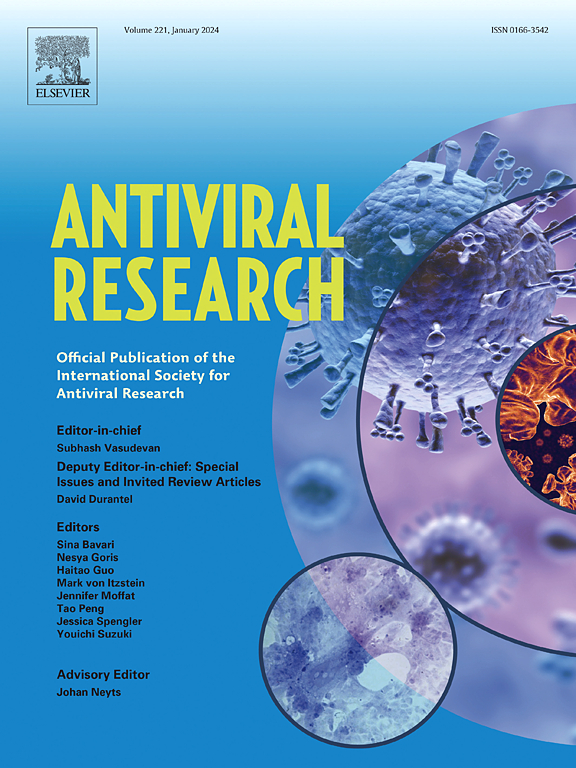Molecular mechanisms of hepatitis B virus entry inhibition by a bile acid derivative INT-767 binding to the preS1 region
IF 4.5
2区 医学
Q1 PHARMACOLOGY & PHARMACY
引用次数: 0
Abstract
Hepatitis B virus (HBV) infection is a leading cause of liver disease worldwide, necessitating the development of novel antiviral agents targeting various steps in the HBV life cycle. The HBV preS1 region mediates critical steps in viral entry, including binding to sodium taurocholate co-transporting polypeptide (NTCP), making it a potential target for anti-HBV drug development. Our previous study suggested that the bile acid derivative INT-767 preferentially attaches to preS1 rather than to NTCP on hepatocytes, indicating that HBV infection is inhibited by INT-767 binding to an important domain of preS1. To elucidate the specific binding interactions between INT-767 and the preS1 region, we performed a preS1 binding assay using fluorescently labeled preS1 peptides and NTCP-expressing HepG2 cells to assess INT-767 binding efficacy. Furthermore, we evaluated the effect of amino acid substitutions in preS1 on both INT-767 binding and HBV infectivity in primary human hepatocytes. The preS1 binding assay revealed that INT-767 interacts specifically with Phe13, Phe14, and His17 in the NTCP-binding region of preS1. Functional analysis demonstrated that substitution of these residues with alanine significantly reduced HBV infectivity, indicating their crucial role in viral entry. INT-767 binding to these residues effectively blocked preS1 interaction with NTCP, thereby inhibiting HBV infection. These findings highlight a novel antiviral mechanism by which INT-767 exerts its anti-HBV effects through direct interaction with preS1, providing a potential therapeutic strategy targeting HBV entry.

胆汁酸衍生物INT-767结合preS1区抑制乙型肝炎病毒进入的分子机制
乙型肝炎病毒(HBV)感染是世界范围内肝脏疾病的主要原因,需要开发针对HBV生命周期各个阶段的新型抗病毒药物。HBV preS1区域介导病毒进入的关键步骤,包括与牛磺胆酸钠共转运多肽(NTCP)的结合,使其成为抗HBV药物开发的潜在靶点。我们之前的研究表明胆汁酸衍生物INT-767优先附着在肝细胞上的preS1而不是NTCP上,这表明INT-767结合preS1的一个重要结构域可以抑制HBV感染。为了阐明INT-767与preS1区域之间的特异性结合相互作用,我们使用荧光标记的preS1肽和表达ntcp的HepG2细胞进行了preS1结合实验,以评估INT-767的结合效果。此外,我们评估了preS1中氨基酸替换对人原代肝细胞中INT-767结合和HBV感染性的影响。preS1结合实验显示,在preS1的ntcp结合区,nt -767特异性地与Phe13、Phe14和His17相互作用。功能分析表明,用丙氨酸取代这些残基可以显著降低HBV的传染性,表明它们在病毒进入过程中起着至关重要的作用。与这些残基结合的INT-767有效地阻断了preS1与NTCP的相互作用,从而抑制HBV感染。这些发现强调了一种新的抗病毒机制,即INT-767通过与preS1的直接相互作用发挥其抗HBV作用,为靶向HBV进入提供了一种潜在的治疗策略。
本文章由计算机程序翻译,如有差异,请以英文原文为准。
求助全文
约1分钟内获得全文
求助全文
来源期刊

Antiviral research
医学-病毒学
CiteScore
17.10
自引率
3.90%
发文量
157
审稿时长
34 days
期刊介绍:
Antiviral Research is a journal that focuses on various aspects of controlling viral infections in both humans and animals. It is a platform for publishing research reports, short communications, review articles, and commentaries. The journal covers a wide range of topics including antiviral drugs, antibodies, and host-response modifiers. These topics encompass their synthesis, in vitro and in vivo testing, as well as mechanisms of action. Additionally, the journal also publishes studies on the development of new or improved vaccines against viral infections in humans. It delves into assessing the safety of drugs and vaccines, tracking the evolution of drug or vaccine-resistant viruses, and developing effective countermeasures. Another area of interest includes the identification and validation of new drug targets. The journal further explores laboratory animal models of viral diseases, investigates the pathogenesis of viral diseases, and examines the mechanisms by which viruses avoid host immune responses.
 求助内容:
求助内容: 应助结果提醒方式:
应助结果提醒方式:


